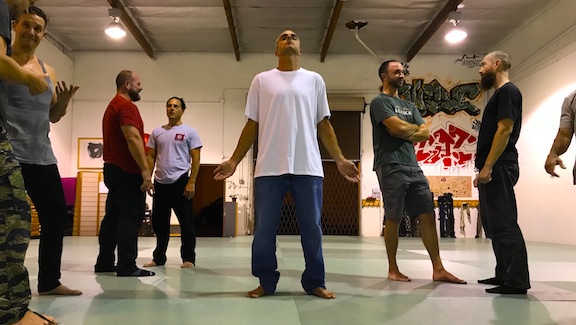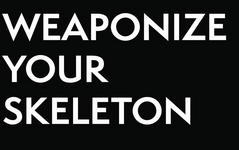Action & Silence: How to Dress for Violence

We have a very simple dress code for seminar training — baggy, loose-fitting blue jeans and a heavy-duty, plain white T-shirt — and yet this generates a surprising amount of pushback from clients. They want to wear yoga pants, tactical BDUs, board shorts, anything but blue jeans; they show up in cute tops, T-shirts festooned with the standard iconography of aggression, logos, product advertisements and political statements. And all that in a spray of every color of the rainbow.
The class ends up looking like a riot at a beach barbecue.
And meanwhile, movement is restricted, no one can put hands on each other like they need to without tearing something, and brains do what brains do — read words and process logos. For your brain it’s a riot of clashing surface noise, obscuring the signal underneath.
Action
You need clothing that won’t bind or restrict your movement, while also being a useful tool for your partner to grab and pull without tearing. In violence, you can grab a fistful of skin or other soft tissue (like the groin) to use as a handle for causing further injury; with loose-fitting, tough clothing we can grab a fistful of fabric instead, saving you from all the screaming and handprint bruises. Tight-fitting and/or light-duty clothing means your partner either 1) can’t practice these things realistically, or 2) they can — but you won’t be happy about it. (Most people, being polite, and, well, people, will default to not practicing the groin-grab — a potentially deadly mistake should they ever need to do just that when their life depends on it. The brain can only go where it’s gone before, and you don’t want the first time you’re going to grab and pull a groin to be during your attempted murder. That’s what training is for — to do it a hundred times so the 101st is nothing new.)
When everyone in the room is dressed for the work, everyone can get the practice they need without interruption or hesitation.
Silence
The choices we make in what to wear on a daily basis are rooted in personal expression and communication — we want to blend and belong or differentiate ourselves (within certain socially-acceptable boundaries) and communicate something about who we are and how we view ourselves and how we wish to have others view us. Clothing is language, and what we need for the optimal practice of violence is dead silence.
The goal on the mats is to create and work in an asocial environment, one that is entirely devoid of communication. Just like at the shooting range, we’re not going to talk while pulling the trigger — because people are bad at doing two things at once, and because we don’t want to train to talk to our targets while we’re in a firefight.
If clothing is communication, then having everyone expressing their individuality through their sartorial choices that morning gives rise to useless noise the brain must ignore in order to get to work on other things… only the brain won’t ignore it because it can’t. (Don’t believe me? Next time you’re out and about try not to read. Ignore the text and logos in your environment. Don’t think about the pink elephant.) A shirt with logos will snag your eye. Words will cry out and demand to be read — and so you will give them voice, echoing in your skull. And while the room might be quiet — save for the sounds of breathing and bodies hitting the mats — that quiet will not be present in your head, where you need it most. We’re silent on the outside so we can be silent on the inside; we want that silence to seep into ourselves so we can do the work of violence with mechanical dispassion — cool, calm, focused.
When everyone you’re training with is dressed the same — blue pants, white shirt — it allows your brain to look for and recognize similarities and differences in SHAPE, to build a generic target map of the human machine. It’s the same machine every time, just a little taller, or wider, or shorter in the torso; but the groin is always where the legs meet, the solar plexus is always dead center in the torso. This is the process of learning the ways in which all individuals are similar — we strip out the individuality of dress and replace it with a flesh-robed skeleton… in blue pants and a white shirt: a blank canvas upon which your brain can paint anatomy.
The dress code isn’t for us, the instructors — it’s not about control, or institutional uniformity, or even looking professional — it’s for you, so you get the most out of the experience. If everyone in the room is quiet and useful we can all get straight to training in dead silence, to pack a thousand turns into the weekend so that the 1,001st — the one where your life is on the line — is nothing new.
— Chris Ranck-Buhr


Oh the skin grabs, meat grabs & the skin pinches from being stepped on purposefully or not. Agreed, I much prefer the clothing take most of that.
Silence during the workout is always an issue.
Exactly! The recommended clothing is simply a training tool, and not about projecting an image.
We just completed a weekend course for SEALFIT
https://sealfit.com
where everyone showed up properly attired—and it made a HUGE difference in both the tenor of the class and the amount of good work we were able to do. The lack of “noise” from clashing words and logos reinforces the silence of the asocial environment, allowing the whole mind to focus on anatomy and movement.
Everything we do in training is intentional and has a purpose, down to how we dress for it.